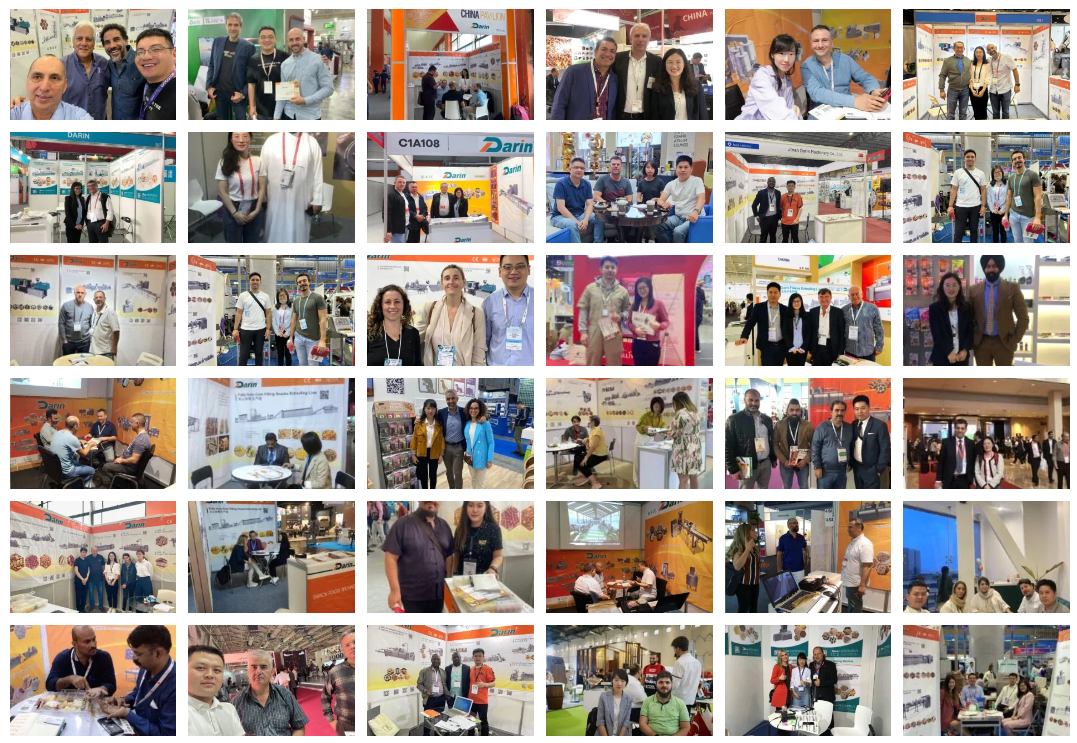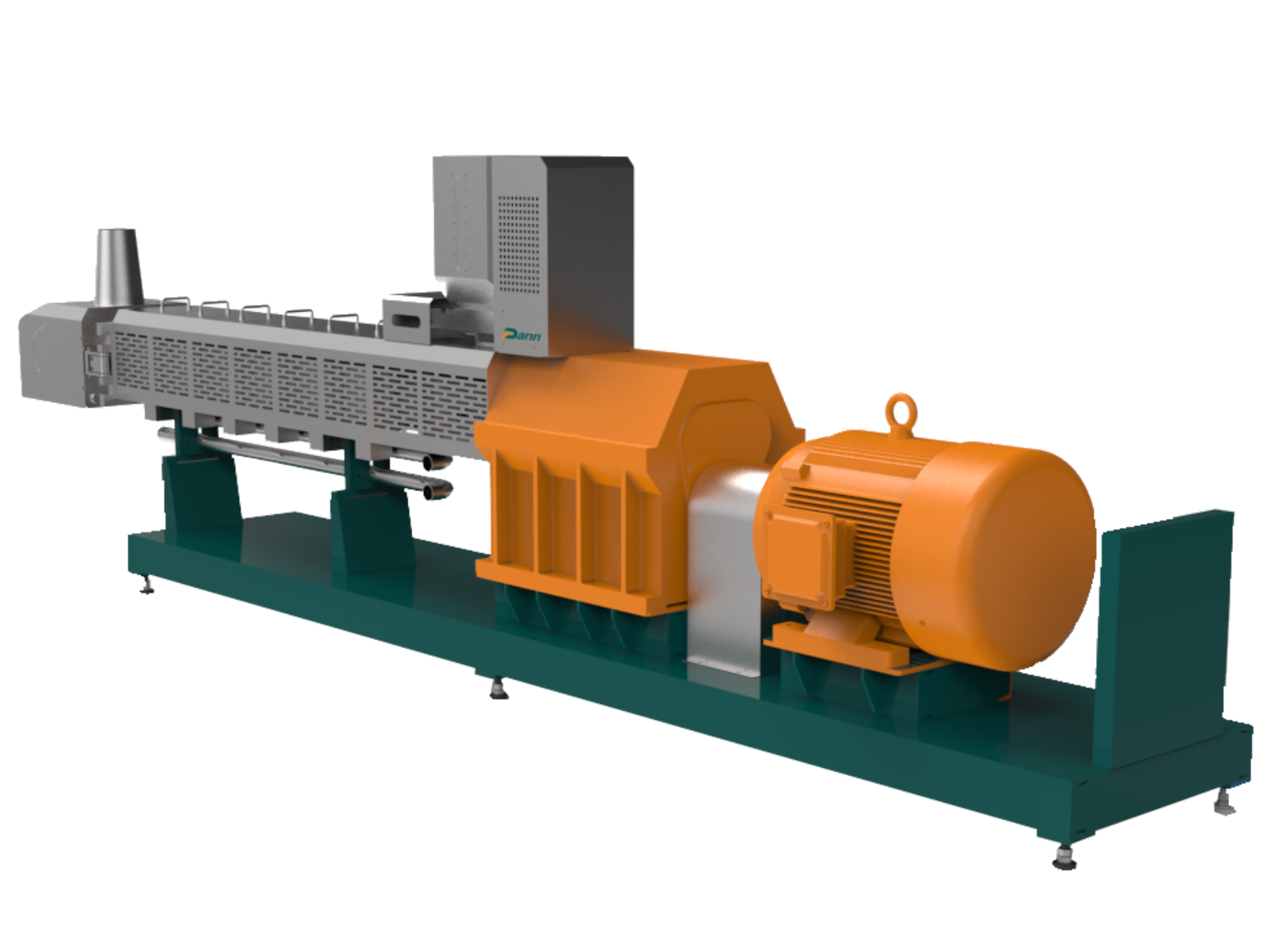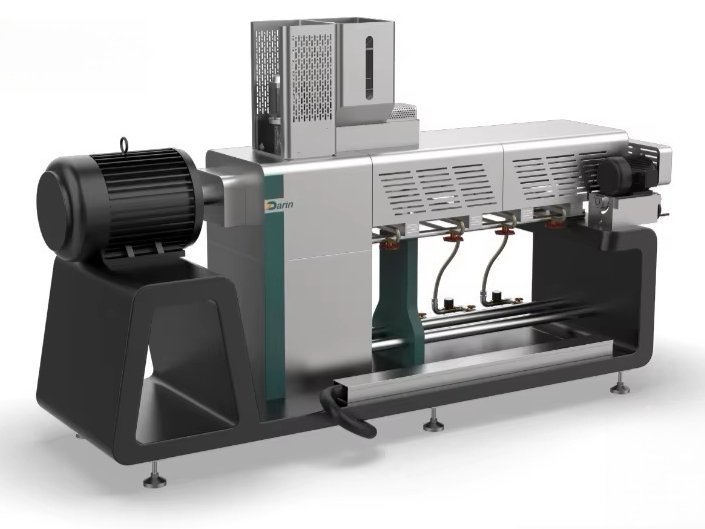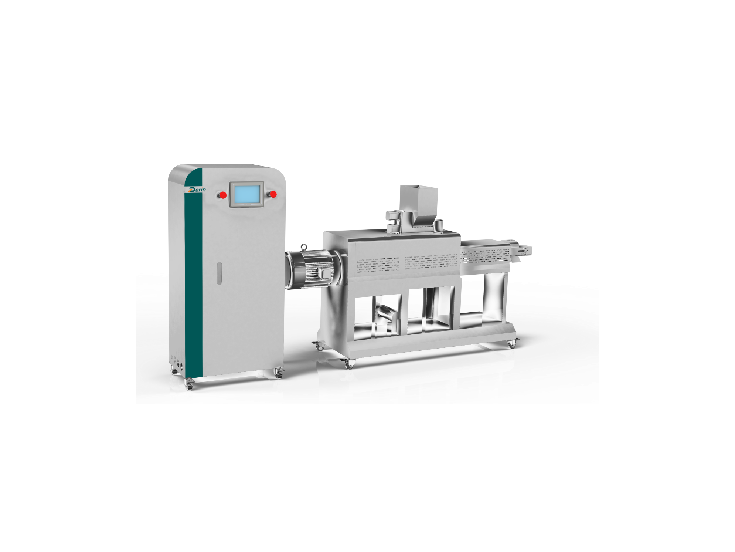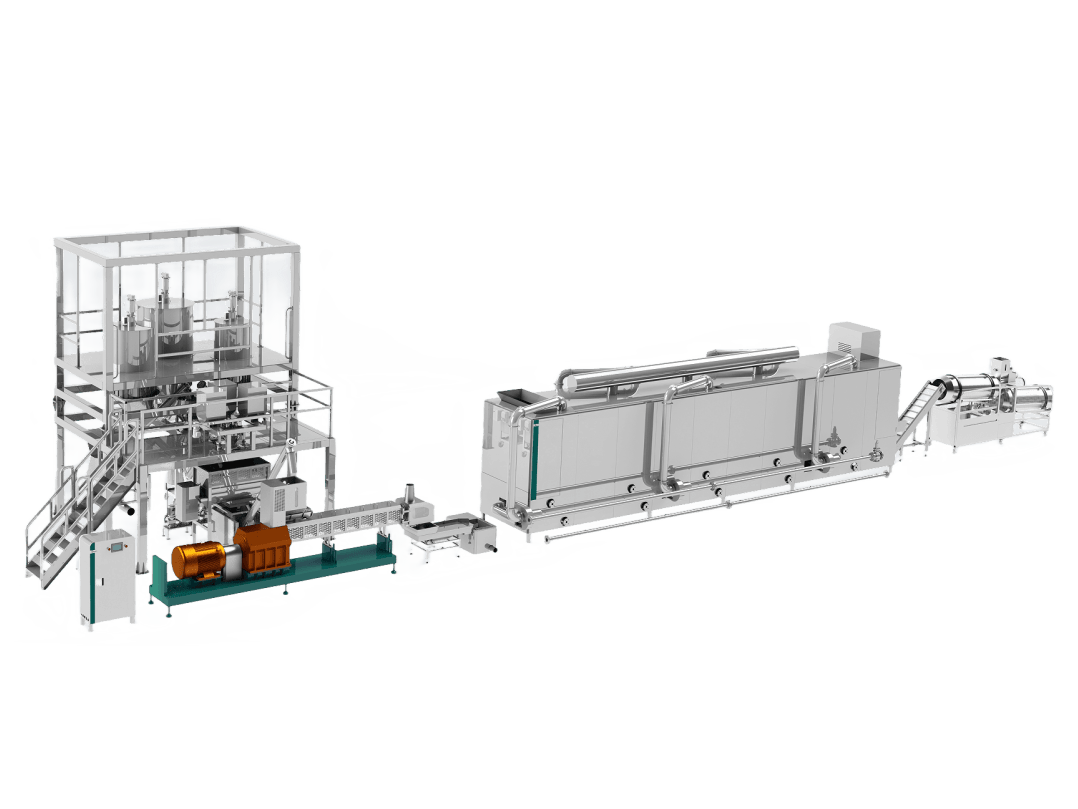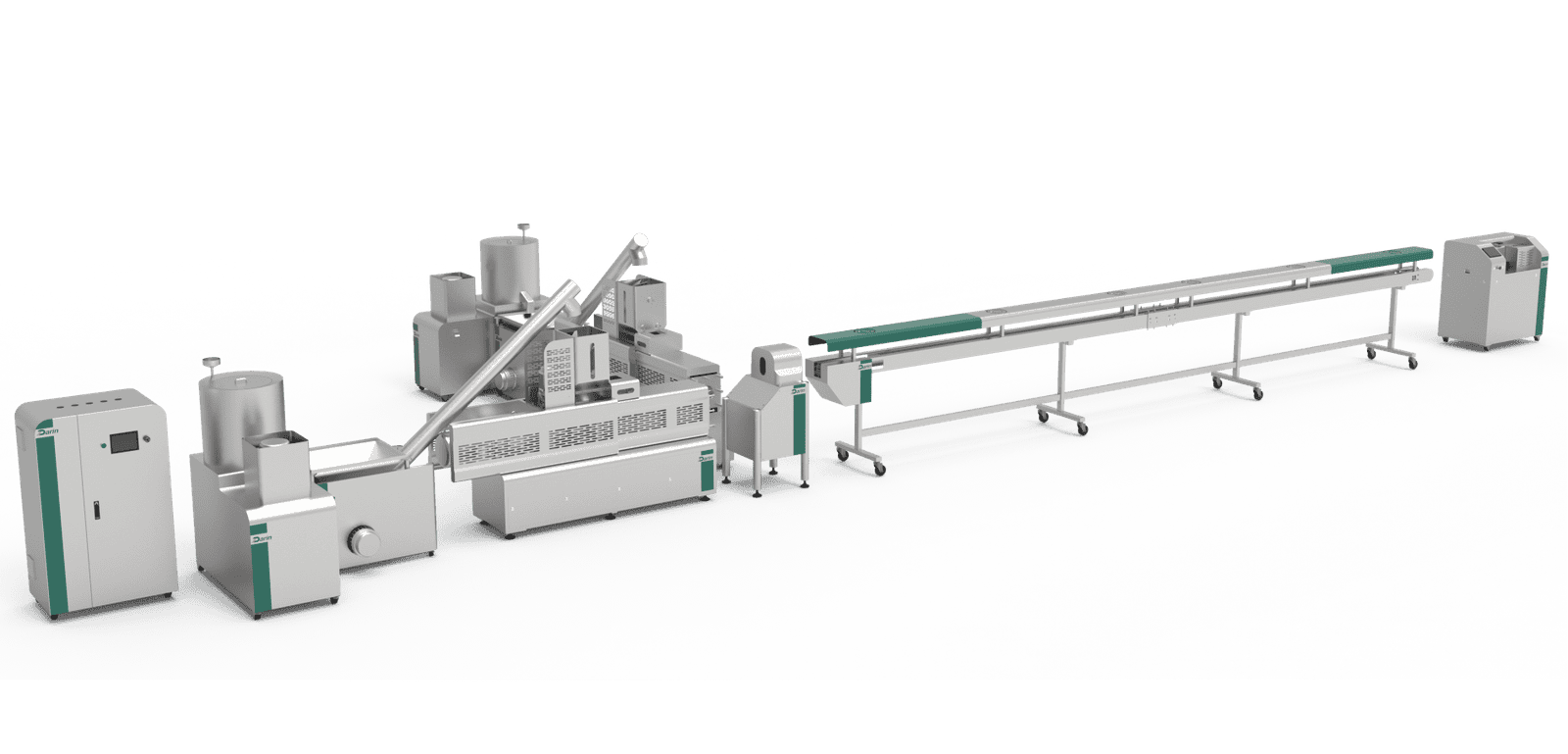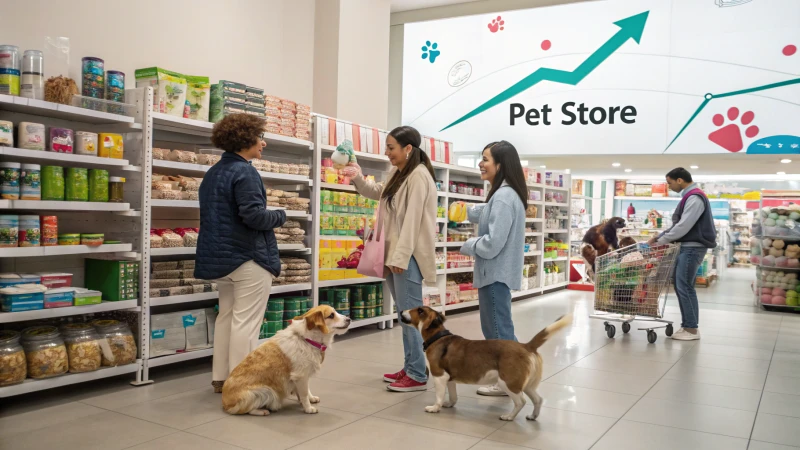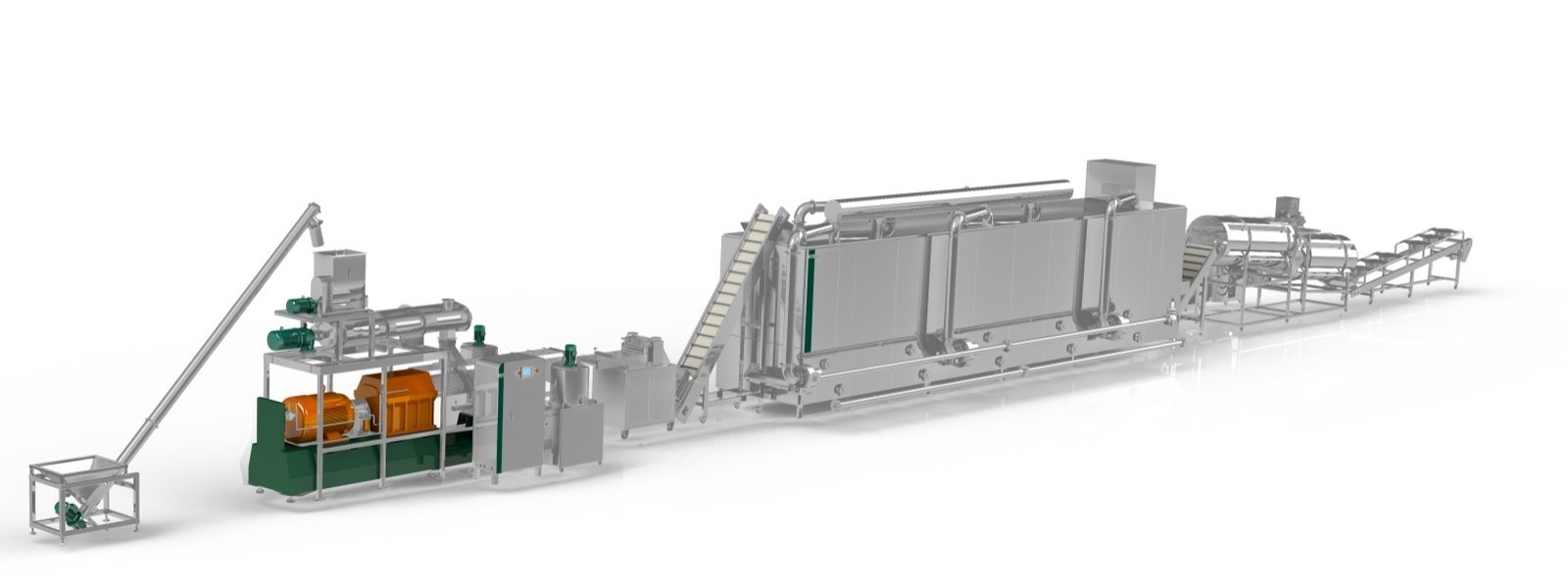
In the global pet food industry, manufacturers face increasing challenges in producing diverse, high-quality snacks for dogs, cats, fish, and birds. Consumers demand safer, healthier, and more functional pet treats — yet behind every crunchy biscuit or chewy jerky is a complex production system. Without a properly engineered pet snack production line, issues such as inconsistent texture, microbial contamination, and nutrient loss can occur, leading to product rejection and brand damage. Fortunately, today’s integrated, automated pet snack production lines from Darin Machinery provide a scalable solution that ensures quality, efficiency, and flexibility across multiple product types.
A pet snack production line is an automated industrial system designed to mix, cook, shape, dry, and package diverse pet snacks — such as dog biscuits, cat treats, fish pellets, and bird sticks — using advanced extrusion, baking, or forming technologies to ensure nutritional balance, texture control, and consistent output across species.
This guide explains in depth how these lines are designed, the machinery involved, and the step-by-step process from raw ingredients to finished treats. Whether you are setting up a new factory or upgrading an existing line, the technical insights below will help you design a cost-effective and efficient pet snack production solution.
Pet snack production lines can only produce one type of pet food per system.False
Modern multi-species pet snack lines can handle various recipes for dogs, cats, fish, and birds by changing die heads, formulation, and drying parameters.
Step-by-Step Overview of the Pet Snack Production Line
Below is the general process flow used by professional manufacturers like Darin Machinery, optimized for multi-species applications:
| Step | Process | Key Equipment | Function |
|---|---|---|---|
| 1 | Ingredient Preparation | Grinder, Mixer, Feeder | Prepares raw materials and ensures even particle size |
| 2 | Extrusion or Forming | Twin-Screw Extruder, Molding Machine | Cooks and shapes dough under controlled temperature and pressure |
| 3 | Cutting & Shaping | Rotary Cutter, Punch Cutter | Produces biscuits, sticks, bones, or pellets in desired forms |
| 4 | Drying | Multi-layer Belt Dryer | Removes moisture for long shelf life |
| 5 | Coating or Flavoring | Coating Drum, Sprayer | Adds palatants, oils, or vitamins |
| 6 | Cooling | Cooling Conveyor | Prevents condensation before packing |
| 7 | Packaging | Automatic Packing Machine | Seals products into pouches or jars |
| 8 | Quality Control | Metal Detector, Check Weigher | Ensures safety, consistency, and compliance |
Ingredient Preparation and Formulation Engineering
A successful pet snack production line begins with the correct formulation. Each animal species has unique nutritional needs:
| Species | Protein (%) | Fat (%) | Fiber (%) | Moisture (%) | Example Ingredient Sources |
|---|---|---|---|---|---|
| Dog | 20–30 | 8–15 | 3–5 | <12 | Chicken meal, corn, wheat, rice |
| Cat | 28–40 | 10–20 | 1–3 | <12 | Fish meal, meat powder, taurine supplement |
| Fish | 30–45 | 5–12 | 2–4 | <10 | Fish meal, soybean meal, starch |
| Bird | 15–25 | 3–8 | 5–10 | <10 | Cereal grains, vegetable oil, honey |
High-precision weighing and mixing systems ensure recipe consistency. Automatic batching systems integrate PLC control, allowing recipe recall for different products. Pre-conditioning (adding steam and moisture before extrusion) enhances starch gelatinization and protein denaturation, key for digestibility and binding.

Extrusion or Forming Technology
Twin-Screw Extrusion for Pet Snacks
Extrusion is the heart of most pet snack production lines. The twin-screw extruder from Darin Machinery provides shear, mixing, and cooking within a short residence time. Adjusting temperature, screw configuration, and die shape allows manufacturers to create products ranging from semi-moist sticks to crispy baked snacks.
Key technical parameters:
- Barrel temperature: 80–180 °C
- Screw speed: 200–600 rpm
- Feed moisture: 15–25 %
- Output capacity: 100–1000 kg/h per line
- Material: Food-grade stainless steel (SS304/SS316)
Extrusion offers versatility: with different die molds and screw profiles, the same line can produce dog chews, cat crunchy bites, fish feed pellets, or bird snack sticks. By injecting air or steam, puffed structures can be achieved; by lowering temperature and using forming dies, dense chewy textures can be produced.
Twin-screw extruders are less efficient than single-screw extruders for pet snacks.False
Twin-screw extruders offer superior mixing, temperature control, and flexibility for complex recipes, making them the preferred choice in modern pet snack production.

Molding and Forming Machines
For products like rawhide bones, meat strips, and pressed biscuits, mechanical forming replaces extrusion. The forming machine applies high pressure and temperature to shape dough or rawhide sheets. Changeable molds allow different designs — bone, ring, star, or heart shapes. The machine integrates automatic feeding and demolding for high throughput and hygiene.
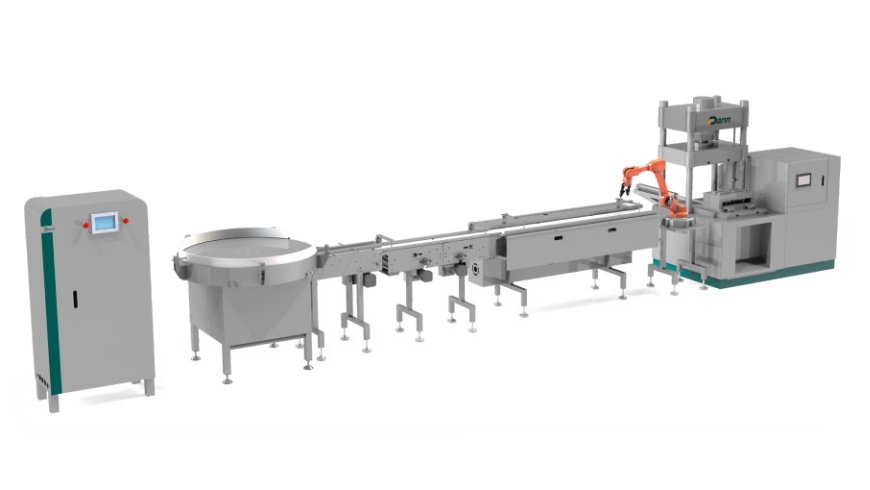
Cutting and Shaping Systems
Cutting precision determines the uniformity of product weight and cooking. Rotary cutters work continuously after the extruder die, while guillotine or wire cutters are used for thicker snacks. Adjustable speed and shape templates help maintain standardization across batches.
Example configuration (Darin DR-65 line):
- Extruder die diameter: 2.5–20 mm
- Cutter motor: 0.75 kW variable frequency drive
- Output uniformity deviation: ≤ ±1.5 %
- Max cutting speed: 150 cuts/min
A combination of mechanical control and vision inspection ensures every snack piece meets shape requirements before drying.
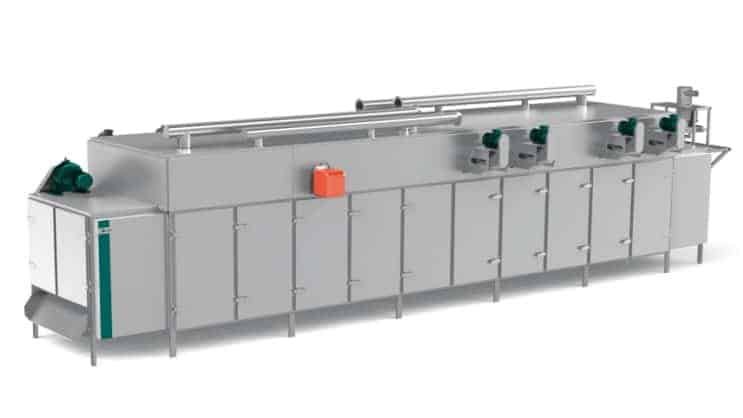
Drying and Moisture Control
After forming, snacks enter a multi-layer belt dryer, which controls moisture reduction precisely. Proper drying ensures:
- Extended shelf life (6–12 months)
- Crunchy texture or flexible chew
- Prevention of mold growth
Technical specifications of Darin Multi-Layer Dryer:
- Drying temperature: 80–150 °C
- Number of layers: 5–8
- Heating options: Electric, gas, steam
- Conveyor speed: Adjustable 0.1–1 m/min
- Final moisture: ≤ 10 %
Moisture Profile Curve Example:
| Stage | Time (min) | Temperature (°C) | Moisture (%) |
|---|---|---|---|
| Inlet | 0 | 100 | 25 |
| Mid-section | 20 | 130 | 14 |
| Outlet | 40 | 120 | 9 |
Consistent airflow and heat balance are maintained via PID temperature control, reducing energy waste and avoiding overdrying. For fish or bird snacks requiring lightweight texture, lower temperature and slower speed profiles are used.
Coating and Flavoring System
After drying, snacks pass through a flavoring drum or spraying system, where oils, attractants, and nutritional additives (vitamins, omega-3s, probiotics) are applied. Uniform coating improves palatability and aroma.
- Drum material: Stainless steel 304
- Drum diameter: 800–1000 mm
- Spray control: Pneumatic atomization
- Coating accuracy: ±1 %
- Optional liquid addition: 2–5 % of product weight
This process can be batch or continuous. For fish and bird snacks, flavoring may include fish oil or honey glaze, respectively. In addition, Darin’s automatic metering ensures no oil loss and easy cleaning between recipes.
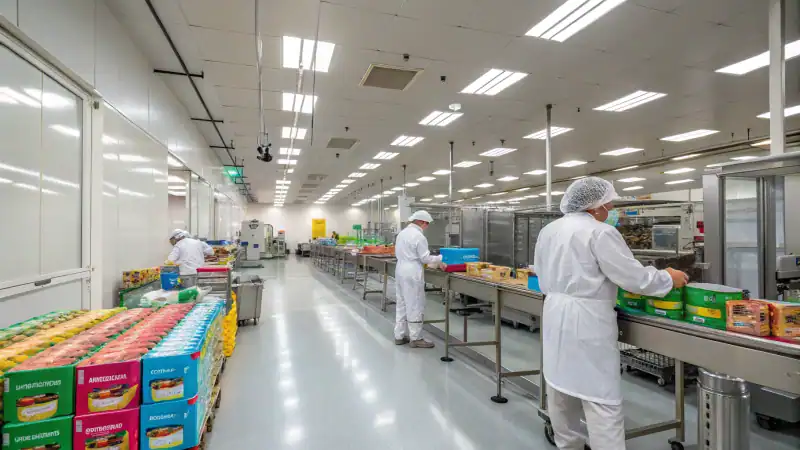
Cooling and Packaging
Cooling prevents moisture condensation in sealed bags. Cooling conveyors use filtered ambient or chilled air to lower the temperature to ≤ 35 °C before entering the packaging section. The automatic packaging machine then fills, seals, and codes each pack.
Packaging options:
- Pillow bags
- Stand-up pouches (with zipper)
- Jars or trays
Key parameters:
- Packing speed: 30–80 packs/min
- Weight range: 50–1000 g
- Material compatibility: OPP/CPP, PET/PE, aluminum foil
- Integrated printer: Date, batch code, QR code
Quality control includes:
- Metal detector (ferrous/non-ferrous detection ≤ 0.8 mm)
- Check weigher (±0.2 g accuracy)
- Visual inspection for color and shape consistency
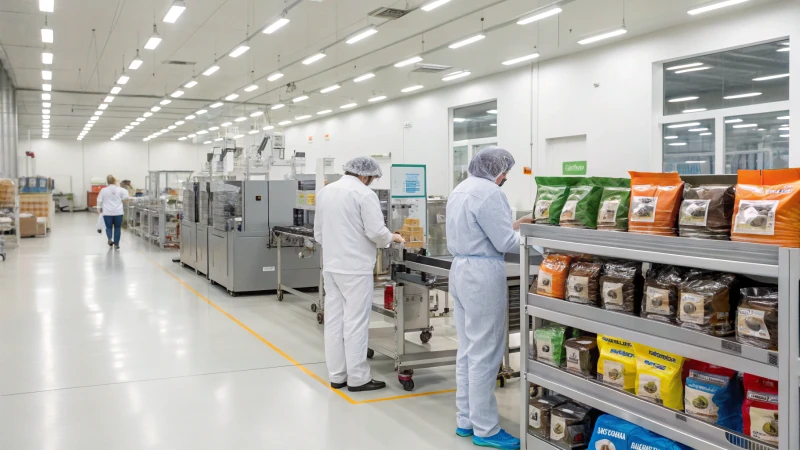
Automation, Control, and Data Integration
Modern lines are integrated via PLC + HMI touch control systems. Recipe storage, temperature logs, and alarm functions are all automated. Optional IoT modules enable real-time monitoring and remote service support.
| Automation Feature | Description | Benefit |
|---|---|---|
| PLC Control | Siemens / Delta PLC | Stable, precise process regulation |
| Touchscreen HMI | Multi-language interface | Easy operation |
| Recipe Memory | Up to 100 formulations | Quick changeover |
| Data Logging | USB or Cloud output | Traceability |
| Remote Diagnosis | Online service from Darin | Maintenance efficiency |
The entire line can be modularly configured — meaning clients can start with a semi-automatic setup and upgrade to full automation as production grows.
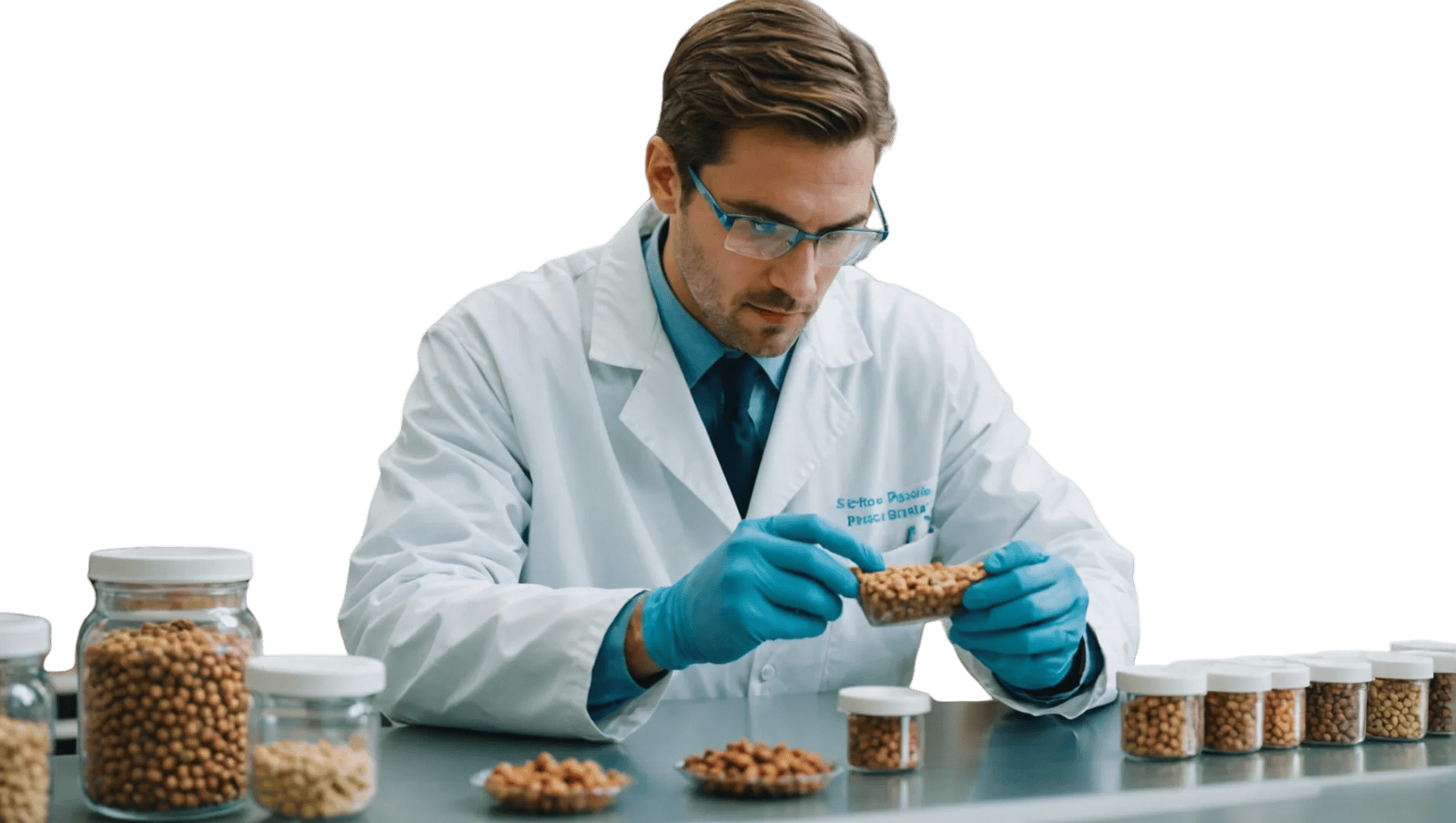
Industrial pet snack production requires more than speed and automation — it demands precision, hygiene, and compliance. Whether producing dog biscuits, cat chews, or fish feed sticks, the difference between a trusted brand and a failing one lies in consistent product quality and sanitary manufacturing practices. In this section, we’ll dive into how modern factories — particularly those using Darin Machinery’s automated snack lines — maintain top-tier standards from ingredient handling to final packaging.
Quality Control in Pet Snack Manufacturing
Quality control (QC) ensures every batch meets nutritional, physical, and microbial specifications. Effective QC systems combine in-line automation with laboratory verification.
In-Process Quality Control
| Stage | Parameter Monitored | Testing Method | Frequency |
|---|---|---|---|
| Ingredient intake | Moisture, particle size | Moisture analyzer, sieve test | Each batch |
| Mixing | Homogeneity | Visual + chemical test | 1/3 batch |
| Extrusion | Temperature, pressure, torque | PLC monitoring | Continuous |
| Drying | Final moisture content | Moisture analyzer | Every 2 hours |
| Coating | Oil absorption rate | Gravimetric method | Random sample |
| Packaging | Weight, seal integrity | Check weigher + vacuum test | Continuous |
Automation Integration:
Sensors throughout the line send data to the PLC, automatically adjusting parameters (e.g., feed rate or drying time). This real-time feedback ensures product uniformity and reduces waste.
Laboratory Quality Control
Beyond in-process testing, labs verify product compliance with nutritional claims and microbiological safety:
| Test Type | Target | Standard Reference | Frequency |
|---|---|---|---|
| Crude Protein | ≥ Specified % | AOAC 990.03 | Weekly |
| Fat & Fiber | Product dependent | AOAC 920.39, 962.09 | Weekly |
| Microbial count | < 10³ CFU/g | ISO 21527 | Weekly |
| Salmonella / E. coli | Absent | ISO 6579 / 16649 | Each batch |
| Heavy metals | Pb, Cd, As | GB/T 5009 | Monthly |
The QC lab also verifies palatability and stability through storage and feeding tests — ensuring treats maintain freshness and appeal during shelf life.
Pet snack lines do not require microbiological testing if heat treatment is used.False
Even after extrusion or baking, microbiological testing is essential to verify food safety, as recontamination can occur during cooling or packaging.
Hygiene and Sanitary Design
Cleanability is fundamental to any food processing line. Pet food, though intended for animals, must adhere to human-grade food safety principles due to export and regulatory standards (e.g., FDA, FEDIAF, CFDA).
Hygienic Equipment Design Principles
| Element | Design Feature | Function |
|---|---|---|
| Surface | Smooth, polished SS304 | Prevents bacterial accumulation |
| Corners | Rounded, no dead zones | Easy cleaning |
| Welding | Continuous, full penetration | Avoids cracks |
| Joints | Sealed or removable | Prevents residue trapping |
| Supports | Elevated >150 mm | Floor cleaning access |
CIP (Clean-in-Place) and SIP Systems
Darin Machinery’s advanced lines support CIP (Clean-in-Place) and SIP (Steam-in-Place) modules, which automate cleaning without dismantling equipment.
CIP System Structure:
- Alkaline washing tank
- Acid rinse tank
- Hot water rinse tank
- Circulation pumps and sensors
- Automatic cleaning sequence (30–60 minutes per cycle)
Advantages:
- Reduces downtime by 30–40 %
- Ensures consistent cleaning results
- Saves labor and water
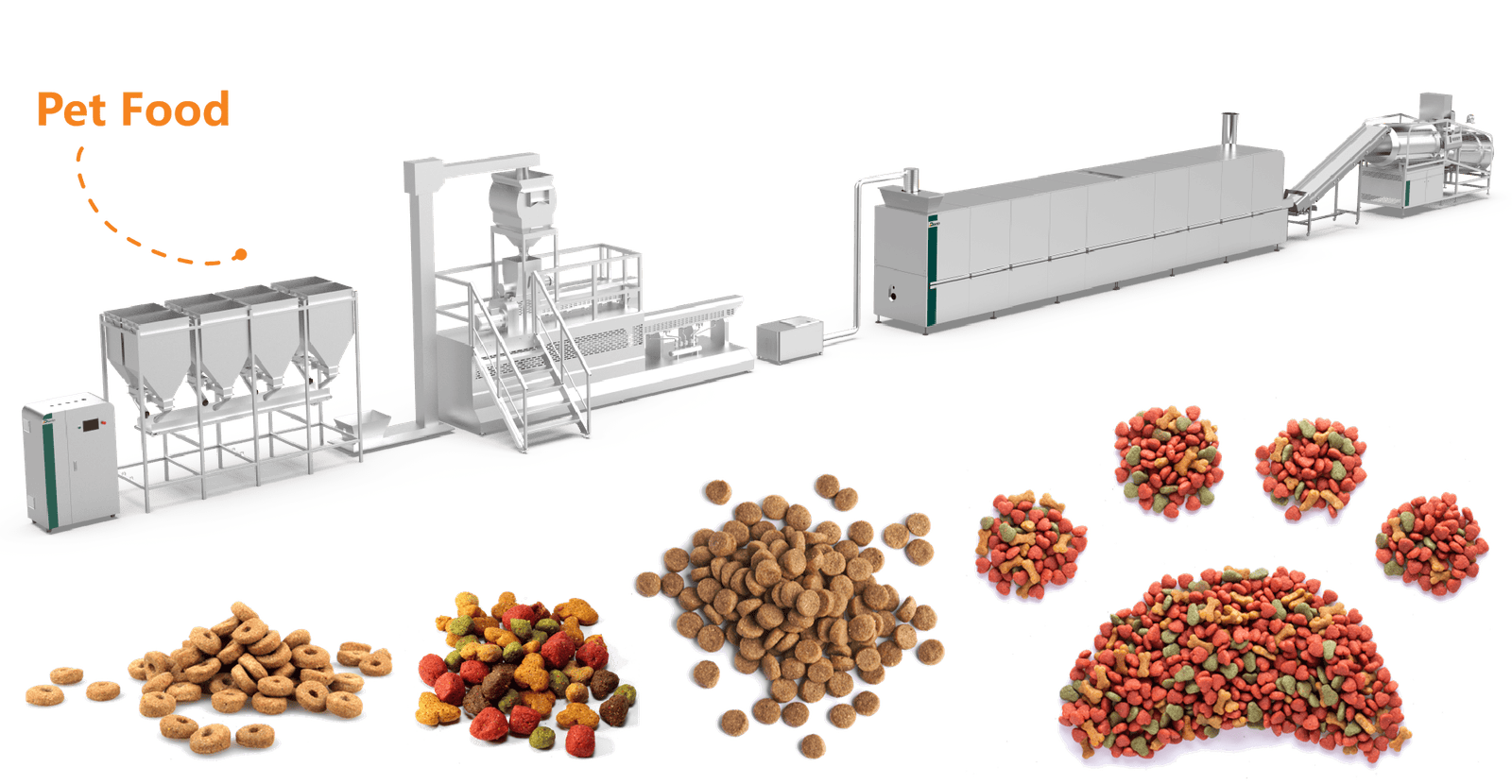
Energy Efficiency and Sustainability
With energy costs rising, efficiency and sustainability have become key design goals. Darin Machinery integrates energy recovery, smart control, and eco-materials into its production lines.
| System | Energy Optimization Method | Typical Energy Saving |
|---|---|---|
| Multi-layer dryer | Heat recycling system | 20–25 % |
| Extruder barrel | Zoned temperature control | 10–15 % |
| Air compressor | Variable frequency drive (VFD) | 15–20 % |
| Lighting | LED with motion sensor | 40 % |
| Cooling system | Ambient air reuse | 15 % |
Waste Minimization:
Waste crumbs or off-spec products can be re-ground and reintroduced into the mix (up to 5 %), reducing raw material loss. Oil sprays and flavoring systems use precision metering to prevent overuse and spills.
Pet snack factories usually release untreated wastewater into the environment.False
Modern factories implement wastewater treatment and filtration systems to comply with environmental standards and achieve sustainable operation.
Cost Analysis and Investment Planning
Setting up a full pet snack production line involves balancing capital expenditure (CAPEX) and operational expenditure (OPEX). The following example offers a realistic industrial perspective.
Example — Medium Capacity Line (500 kg/h)
| Category | Description | Estimated Cost (USD) |
|---|---|---|
| Main equipment (extruder, dryer, coating, packer) | Core machinery | 150,000 – 250,000 |
| Auxiliary equipment (mixer, crusher, conveyors) | Support units | 30,000 – 60,000 |
| Installation & training | On-site setup | 10,000 – 20,000 |
| Utilities (air, steam, water systems) | Facility setup | 15,000 – 30,000 |
| Total CAPEX | 200,000 – 360,000 | |
| Operation cost (labor, energy, raw materials) | Monthly OPEX | 15,000 – 25,000 |
| ROI period | Payback via sales | 1.5 – 2.5 years |
Economic Insight:
High-efficiency extrusion lines reduce energy and waste, leading to lower per-unit costs. Moreover, versatility (multi-species production) increases ROI by allowing the same equipment to serve multiple product markets.
Global Compliance and Certification
For global exports, compliance with food safety regulations and certifications is non-negotiable. Darin Machinery’s production lines are designed according to international norms such as CE, ISO9001, HACCP, FDA, and FEDIAF.
| Standard | Region / Authority | Scope of Compliance |
|---|---|---|
| CE | European Union | Machinery safety and electrical compliance |
| ISO9001 | Global | Quality management system |
| HACCP | Global | Hazard analysis and critical control points |
| FDA CFR 21 | USA | Food contact material safety |
| FEDIAF | Europe | Pet food nutritional and labeling guidelines |
| CFDA | China | Domestic production license and inspection |
Traceability Systems:
- Batch numbering and barcode integration
- Ingredient origin tracking
- Export-ready digital documentation (COA, COC, CE declaration)
By implementing full traceability, manufacturers protect their brand reputation and meet retailer and importer requirements.
Case Study — Multi-Species Snack Line by Darin Machinery
Client: Southeast Asian Integrated Pet Food Manufacturer
Challenge:
The client wanted a multi-purpose line capable of producing dog chews, cat treats, and floating fish feed with minimal changeover time.
Solution by Darin Machinery:
Installed a DR-70 twin-screw extrusion line with:
- Interchangeable die sets for various shapes (bone, ring, pellet)
- Automated dryer with recipe memory
- Continuous flavoring drum for species-specific coating
- PLC system enabling quick parameter switch (from dog treats to fish feed in <1 hour)
Results after 6 months:
- Output capacity: 600 kg/h
- Production flexibility: 3 product types/day
- Waste reduction: 8 % → 2 %
- Energy saving: 22 %
- ROI achieved within 18 months
Maintenance, Training, and After-Sales Support
Darin Machinery emphasizes lifetime support and training to maintain high efficiency.
| Service | Description | Interval |
|---|---|---|
| Operator Training | On-site and remote sessions | Before commissioning + annually |
| Preventive Maintenance | Component inspection, calibration | Quarterly |
| Spare Parts Supply | In-stock standard components | 48-hour delivery |
| Remote Diagnosis | Online troubleshooting via PLC connection | On-demand |
| Upgrade Packages | New die sets, recipe integration | Every 1–2 years |
Pet snack production lines require complete shutdown for maintenance.False
Modular design allows section-by-section maintenance; critical cleaning or repairs can be performed without halting the entire system.
Future Trends in Pet Snack Production
As the pet economy evolves, pet snack production lines are becoming smarter, more personalized, and more sustainable. Key emerging trends include:
- AI-based process optimization: Using machine learning to predict product quality and automatically adjust parameters.
- Functional snacks: Enriched with probiotics, collagen, or plant-based proteins.
- 3D-printed pet treats: Precision-formed shapes for individualized nutrition.
- Digital twins for production: Virtual simulation of entire lines for predictive maintenance.
- Full recyclable packaging: Shift from multilayer plastic to mono-material or compostable films.
Manufacturers investing now in flexible and digital-ready lines will lead the market for years to come.
Pet snack production lines today are not merely mechanical systems — they are smart, hygienic, and sustainable ecosystems enabling manufacturers to deliver safe, nutritious, and attractive snacks for dogs, cats, fish, and birds. From ingredient preparation to final packaging, each stage relies on scientific design and precision control. By integrating automation, energy efficiency, and compliance, factories can meet the growing global demand while minimizing cost and waste.

As pet food companies expand globally, plant designers face two critical challenges: achieving high throughput while maintaining recipe flexibility. In this section, we provide a detailed engineering perspective on how modern Darin Machinery pet snack production lines are configured, scaled, and optimized for space, energy, and efficiency. Each configuration can be adapted for dog, cat, fish, or bird snacks, offering multi-species versatility with rapid product changeovers.
Typical Process Flow of a Pet Snack Production Line
The process flow below represents a full-scale Darin Machinery production system, integrating all mechanical and control sections.
Flow Diagram:
Raw Materials → Grinding → Mixing → Extrusion / Forming → Cutting → Drying → Coating → Cooling → Packaging → Quality Inspection → StorageEach arrow represents material movement through stainless-steel conveyors or pneumatic transfer systems under hygienic design. The entire system can be arranged linearly or in a U-shaped layout depending on factory space and utilities.
Equipment-by-Equipment Technical Specification
The following table outlines Darin Machinery’s standard configuration for a 300–1000 kg/h multi-species snack production line.
| Equipment | Model | Capacity (kg/h) | Key Features | Power (kW) | Material |
|---|---|---|---|---|---|
| Grinder | DRG-300 | 300–600 | Hammer mill, variable screen size | 15 | SS304 |
| Mixer | DRM-500 | 300–1000 | Double shaft paddle mixer, 99% uniformity | 11 | SS304 |
| Feeder | DRF-65 | 200–1000 | Variable speed screw feeder | 1.1 | SS304 |
| Extruder | DR-65 / DR-70 / DR-85 | 100–1000 | Twin-screw, digital temperature zones | 37–90 | SS304/SS316 |
| Cutter | DRC-200 | 100–800 | Rotary knife or guillotine | 0.75 | SS304 |
| Dryer | DRD-5L | 300–1200 | Multi-layer, PID control | 75 | SS304 |
| Coating Drum | DRC-800 | 200–1000 | Liquid/oil/powder coating | 3 | SS304 |
| Cooling Conveyor | DRCC-1000 | 300–1000 | Air-cooled, adjustable speed | 2 | SS304 |
| Packing Machine | DRP-320 / 420 | 30–80 packs/min | Auto weighing, sealing, coding | 3 | SS304 |
| Metal Detector + Checkweigher | Optional | Inline QC | SS304 |
Each module is independent yet fully integrated through PLC control, allowing modular scalability. The line can be expanded simply by upgrading extruder diameter or dryer length without replacing the full system.

Factory Layout Recommendations
When planning a pet snack production plant, layout design affects efficiency, hygiene, and future scalability. Below is an example of a 1000 kg/h plant layout designed by Darin Machinery’s engineering team.
| Zone | Area (m²) | Equipment | Key Notes |
|---|---|---|---|
| Raw Material Storage | 60–100 | Silos, bins | Segregated for grain/meat/flour |
| Mixing & Batching | 40–60 | Mixer, grinder, feeder | Enclosed dust control |
| Extrusion Zone | 50–70 | Extruder, cutter | Ventilation and heat management |
| Drying Section | 80–120 | Multi-layer dryer | Requires exhaust and humidity control |
| Coating & Cooling | 30–50 | Coating drum, conveyors | Food-grade flooring |
| Packaging & QC | 60–80 | Packer, detector, scale | Air filtration required |
| Finished Goods Storage | 100–150 | Pallet racks | Controlled humidity |
| Utility Room | 30–50 | Compressors, steam boiler | Separate from production |
| Office & Lab | 40–60 | QC and control | Centralized monitoring |
Total recommended area: 500–700 m² for 1000 kg/h output.
This modular layout ensures linear material flow, minimal cross-contamination, and easy sanitation access.
Pet snack plants can operate efficiently in non-segregated layouts without hygiene zoning.False
Proper hygiene zoning—raw, cooked, packaging areas—is essential to avoid cross-contamination and meet HACCP and export standards.
Line Configurations by Capacity
Darin Machinery offers scalable configurations to suit startups, mid-sized plants, and industrial-scale factories.
| Line Type | Capacity (kg/h) | Recommended Model | Power Requirement | Factory Space | Labor Requirement |
|---|---|---|---|---|---|
| Entry-level | 100–300 | DR-65 | 60–75 kW | 200–300 m² | 3–4 persons |
| Mid-range | 300–600 | DR-70 | 90–110 kW | 300–500 m² | 4–5 persons |
| Industrial | 600–1000 | DR-85 | 120–150 kW | 500–700 m² | 5–7 persons |
| High-output | 1000–2000 | DR-95 | 180–250 kW | 700–1200 m² | 6–8 persons |
Power Supply: 380V / 50Hz three-phase (customizable 220V–480V for exports)
Compressed Air: 0.6–0.8 MPa
Steam (optional): 0.3–0.6 MPa for preconditioner or dryer
Remark: Output capacity depends on moisture, formula, and product shape. For example, fish feed pellets yield slightly lower throughput due to higher moisture and density.
Product Forming and Die Design
In extrusion or forming, die design determines snack shape and density. Darin Machinery provides over 150 die templates for customization.
| Shape | Typical Size (mm) | Suitable Product | Texture Type |
|---|---|---|---|
| Bone | 70 × 25 | Dog chew | Dense, tough |
| Ring | Ø30 | Dog/cat snack | Medium-hard |
| Star | Ø15 | Fish/bird treat | Crisp |
| Heart | 20 × 18 | Cat snack | Crunchy |
| Stick | 80 × 10 | Dog chew | Semi-moist |
| Pellet | Ø2–8 | Fish feed | Floating/sinking |
| Cube | 10 × 10 × 10 | Universal | Crunchy or soft |
Die material: Hardened stainless steel or alloy steel with Teflon coating for non-stick properties.
Changeover time: 20–30 minutes with modular die head assembly.
Extruder Screw Configuration
Each product type requires specific screw configuration to achieve ideal shear, pressure, and residence time.
| Product Type | Screw Profile | Barrel Temp (°C) | Moisture (%) | Key Process Goal |
|---|---|---|---|---|
| Dog Chews | Low shear | 90–120 | 18–25 | Dense texture |
| Cat Treats | Medium shear | 100–140 | 15–20 | Puff expansion |
| Fish Feed | High shear | 130–180 | 20–30 | Floating ability |
| Bird Snacks | Medium shear | 100–130 | 16–22 | Crispiness |
The screw element design (mixing, kneading, conveying zones) can be rearranged based on product type, allowing the same extruder to switch between applications with minimal downtime.
Drying Curve and Optimization
The drying curve directly influences shelf life and texture.
Below is a comparison of drying curves for various pet snack categories:
| Snack Type | Stage 1 Temp (°C) | Stage 2 Temp (°C) | Stage 3 Temp (°C) | Final Moisture (%) | Texture |
|---|---|---|---|---|---|
| Dog Biscuit | 120 | 130 | 110 | 9–10 | Crunchy |
| Cat Chewy Bite | 100 | 120 | 100 | 12–14 | Semi-soft |
| Fish Pellet | 110 | 140 | 120 | 8–9 | Hard |
| Bird Stick | 90 | 110 | 100 | 10–11 | Light, crisp |
By adjusting belt speed and air circulation, the line ensures each product achieves target texture and microbiological safety without nutrient degradation.
A higher drying temperature always results in better pet snack quality.False
Overdrying can destroy vitamins and proteins, causing brittle texture and nutrient loss. Optimal temperature varies by product.
Coating & Palatability Enhancement
Palatability — how much pets like the product — depends largely on coating uniformity and flavor profile. Darin’s rotary coating drum applies liquid (oil, flavor) and powder (vitamins, attractants) evenly across the product surface.
| Coating Parameter | Typical Value | Function |
|---|---|---|
| Rotation Speed | 10–25 rpm | Ensures uniform coverage |
| Spray Pressure | 0.3–0.5 MPa | Atomizes liquid oil |
| Coating Ratio | 2–6 % | Based on formula |
| Oil Temp | 40–50 °C | Improves absorption |
| Drum Angle | 25–30° | Controls residence time |
Flavoring oils for different species:
- Dogs: Chicken oil, beef fat, liver hydrolysate
- Cats: Fish oil, taurine-enhanced palatant
- Fish: Fish oil, shrimp extract
- Birds: Honey, fruit essence, vegetable oil
Proper coating enhances aroma, taste, and visual appeal — crucial for brand differentiation.
Automation and Smart Control Systems
Each Darin Machinery line includes PLC + HMI systems with optional IoT connectivity.
| Function | Description | Benefit |
|---|---|---|
| Recipe Management | 100+ saved formulations | Quick switching |
| Remote Access | Internet-based monitoring | Fast technical support |
| Alarm System | Real-time alerts | Prevents downtime |
| Data Logging | Continuous temperature/pressure trends | Traceability |
| Energy Metering | Monitors kWh per batch | Cost optimization |
Optional Upgrade:
Integration with ERP/MES systems for complete digital manufacturing — production data, maintenance logs, and quality reports can sync directly to a company database.
Recommended Material Handling and Automation Accessories
To improve efficiency and hygiene, the following optional automation units are available:
| Accessory | Function | Benefit |
|---|---|---|
| Vacuum Loader | Transfers raw powder | Dust-free environment |
| Screw Conveyor | Transfers dough or extrudate | Continuous feeding |
| Bucket Elevator | Moves dried product vertically | Compact layout |
| Vibrating Sieve | Removes fines | Quality uniformity |
| Dust Collector | Filters air from mixers | Clean workplace |
| Metal Detector | Detects contaminants | Food safety |
| Automatic Cartoner | Packs bags into cartons | Labor reduction |
Each accessory is modular and can be integrated later — supporting gradual automation upgrades.
Example — Complete Pet Snack Production Line Specification Sheet
| Item | Description |
|---|---|
| Model | DR-85 Multi-Species Snack Line |
| Output Capacity | 800–1000 kg/h |
| Raw Materials | Meat meal, corn, rice, fish meal, starch, vitamins, minerals |
| Product Types | Dog chews, cat treats, fish feed, bird snacks |
| Extruder Type | Twin-screw, variable configuration |
| Dryer Type | 7-layer continuous belt, electric/gas heating |
| Coating System | Rotary drum with dual atomizing sprayers |
| PLC Control | Siemens / Delta with touchscreen HMI |
| Voltage | 380V / 50Hz (customizable) |
| Air Pressure | 0.6–0.8 MPa |
| Steam | Optional 0.4–0.6 MPa |
| Operator Requirement | 5–6 persons |
| CE / ISO / HACCP Certification | Yes |
| Country of Origin | China |
| Manufacturer | Jinan Darin Machinery Co., Ltd. |
Factory Operation and Production Scheduling
Darin Machinery recommends a three-shift operation for optimal output utilization.
| Shift | Duration | Average Output | Maintenance Window |
|---|---|---|---|
| Morning | 8:00–16:00 | 100% | Minor cleaning |
| Evening | 16:00–00:00 | 100% | None |
| Night | 00:00–08:00 | 80% | Weekly full clean-up |
Weekly Cleaning Schedule Example:
- Daily: Surface wipe and product discharge check
- Weekly: Extruder barrel cleaning and die lubrication
- Monthly: Dryer air duct cleaning and sensor calibration
- Quarterly: Bearing lubrication and screw inspection
Integration of Pet Snack Production into Full Pet Food Plants
Many large factories integrate snack production lines with main dry kibble or wet food lines.
Advantages:
- Shared ingredient and utility systems
- Unified packaging center
- Cross-use of flavoring and storage systems
- Flexible production planning for seasonal SKUs
This modular integration model allows both small and large manufacturers to scale effectively.
Summary of Key Technical Insights
| Aspect | Darin Advantage |
|---|---|
| Multi-Species Capability | Produces snacks for dogs, cats, fish, and birds on one line |
| Modular Design | Expandable from 100 to 2000 kg/h |
| Sanitary Engineering | Full SS304/316 construction, CIP-ready |
| Energy Efficiency | 15–25 % energy saving systems |
| Smart Automation | PLC/HMI with IoT upgrade |
| Quick ROI | Typically 18–24 months |
| Global Compliance | CE, ISO, FDA, HACCP certified |
A modern pet snack production line is a symphony of mechanical precision, automation, and food science. Through meticulous process design — from ingredient preparation and extrusion to drying, coating, and packaging — manufacturers can produce safe, delicious, and diverse pet snacks that meet global standards.
Darin Machinery’s solutions are engineered for adaptability: whether you’re producing chewy dog bones, crispy cat treats, floating fish pellets, or natural bird sticks, each component is designed for durability, hygiene, and profitability.

In the modern pet food industry, snack production has evolved from manual shaping and oven drying into a fully automated, data-driven system. Manufacturers now demand not only consistency and hygiene, but also flexibility, traceability, and sustainability. This final part examines process control mechanisms, comparative technologies, and the global applications shaping the next generation of pet snack factories.
Process Control Charts and System Integration
To maintain product stability across thousands of kilograms of daily output, Darin Machinery lines utilize integrated control loops for temperature, moisture, pressure, and energy use. Below is a simplified chart illustrating the main control flow.
Process Control Flowchart
Ingredient Dosing → Mixing → Extrusion → Cutting → Drying → Coating → Cooling → Packaging → QC
↑ ↓
Weight Sensors Temperature Sensors
↓ ↑
PLC Data Bus → SCADA → HMIEach step is governed by feedback control loops, ensuring real-time corrections.
| Control Parameter | Sensor Type | Control Range | Action Triggered | Typical Response Time |
|---|---|---|---|---|
| Extruder Temperature | Thermocouple | ±1°C | Adjust heater zones | 2–3 s |
| Screw Torque | Strain gauge | ±5 % | Adjust feed rate | <1 s |
| Dryer Humidity | Capacitive sensor | ±3 % RH | Adjust exhaust speed | 5–10 s |
| Coating Ratio | Flowmeter | ±0.5 % | Control spray valve | Continuous |
| Product Weight | Load cell | ±0.2 g | Calibrate filler | 2 s |
Data Integration:
All parameters are logged through a PLC-SCADA network, allowing engineers to view performance trends, identify inefficiencies, and forecast maintenance. Historical data forms the foundation for predictive maintenance models.
Manual operators can maintain uniform quality more effectively than PLC-controlled systems.False
Automated PLC and SCADA systems achieve higher precision, faster reaction times, and continuous quality consistency compared to manual control.
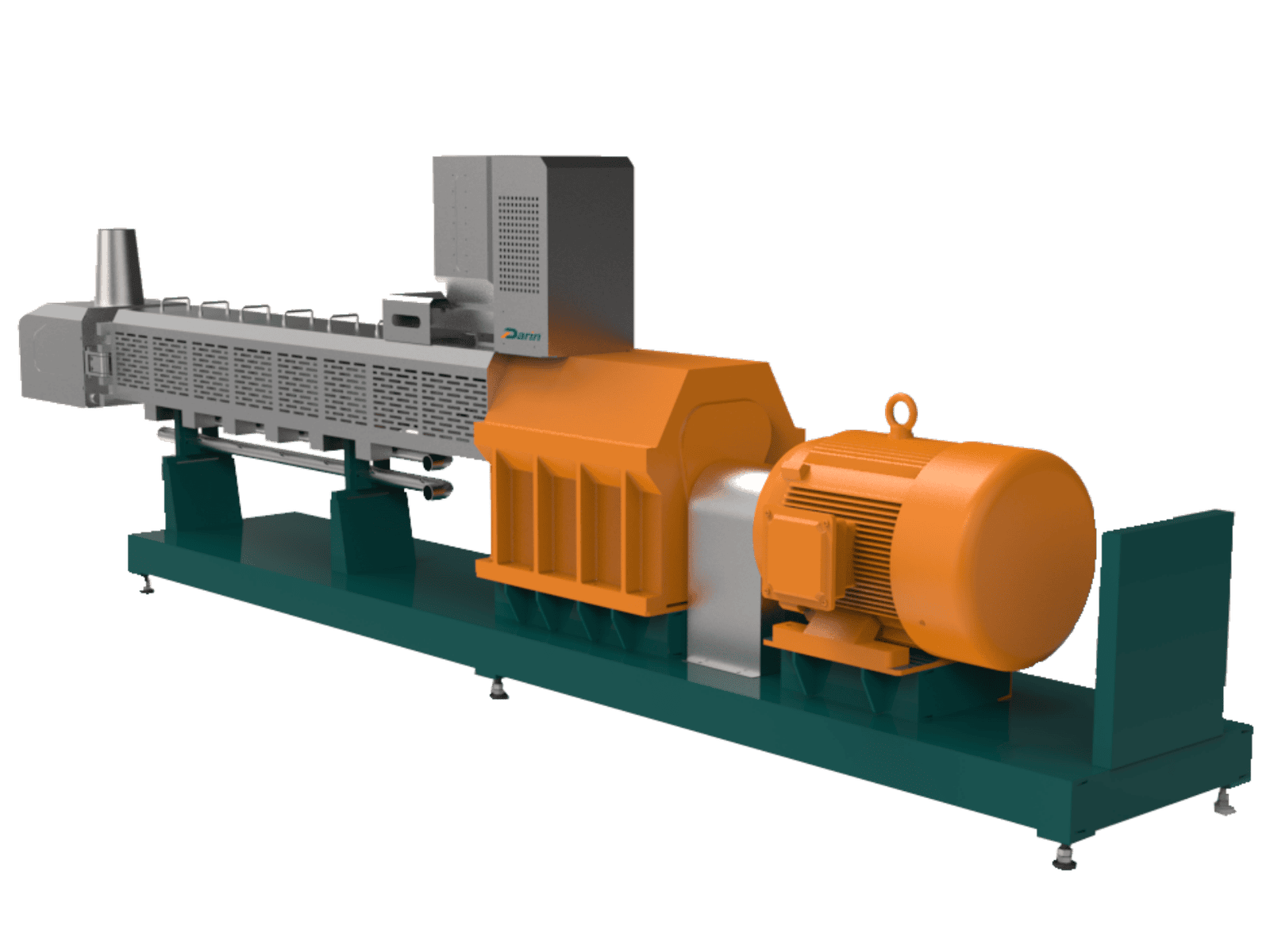
Extrusion vs. Baking in Pet Snack Manufacturing
While both methods are used in the industry, each serves distinct purposes. The following table compares their characteristics to help manufacturers choose the right system.
| Feature | Extrusion System | Baking System |
|---|---|---|
| Core Process | High-temperature short-time cooking using twin screws | Dough sheeting and baking in continuous ovens |
| Typical Products | Chews, semi-moist sticks, pellets, fish feed | Biscuits, cookies, crunchy treats |
| Texture Control | Adjustable via die pressure & moisture | Controlled by baking time & oven temp |
| Nutrient Retention | Excellent due to rapid heating | Moderate, may lose heat-sensitive vitamins |
| Shape Flexibility | Very high — interchangeable dies | Limited to cutter shapes |
| Throughput | 100–2000 kg/h | 150–1000 kg/h |
| Energy Consumption | 15–25 % lower with modern extruders | Higher due to long baking duration |
| Maintenance | Lower, modular components | Moderate, frequent cleaning |
| Investment | Medium | Medium-High (oven cost) |
| Example Model | Darin DR-85 Twin-Screw Extruder | Darin DBL-900 Biscuit Line |
Both technologies can coexist: extrusion for soft chews and functional snacks, baking for biscuits and crunchy products. Hybrid plants often integrate both to expand product portfolios.
Global Applications and Market Adaptation
Pet snack preferences vary globally, influencing formulation and machinery configuration. Darin Machinery customizes production lines to regional dietary norms and regulations.
| Region | Common Product Types | Preferred Machinery | Local Regulation / Standard |
|---|---|---|---|
| North America | Functional chews, grain-free snacks | Extrusion + coating | FDA CFR 21, AAFCO |
| Europe | Oven-baked biscuits, natural treats | Baking line | FEDIAF, CE |
| Asia-Pacific | Fish feed, mixed animal treats | Multi-species extruder | CFDA, ISO |
| Latin America | Meat-based chews, value lines | Twin-screw extruder | SENASA, INVIMA |
| Middle East | Halal-certified snacks | Forming + drying | GCC, Halal certification |
| Africa | Floating fish feed, dog sticks | Extruder + dryer | Regional bureau standards |
Localization Advantages:
- Adaptation to local raw material availability (rice flour, maize, soy, fish meal)
- Compliance with labeling and export standards
- Cost-effective maintenance and technical training in regional languages
Advanced Process Optimization and AI Applications
Industry 4.0 principles are transforming how pet snack factories operate.
Darin Machinery’s R&D division integrates AI-assisted optimization algorithms to enhance output stability and resource utilization.
AI & IoT Applications in Pet Snack Production
| System | Function | Benefit |
|---|---|---|
| Predictive Maintenance | Analyzes vibration, temperature, motor data | Prevents unscheduled downtime |
| Energy Optimization | AI monitors dryer/extruder energy curves | Reduces kWh/t output by up to 15 % |
| Recipe Intelligence | Suggests adjustments based on sensor feedback | Maintains uniform texture |
| Digital Twin | Simulates process changes virtually | Faster new product development |
| Cloud Dashboard | Aggregates real-time data across multiple plants | Centralized management |
Example:
AI-controlled feedback can detect extruder torque deviations and automatically compensate feed rate to maintain consistent density — a task previously handled manually by experienced operators.
AI and IoT systems are still theoretical in pet snack factories.False
Many modern manufacturers, including Darin Machinery clients, actively deploy IoT and AI modules for process optimization and predictive maintenance.
Robotics and Automation in Packaging
Packaging is one of the most labor-intensive processes. The latest robotic packaging cells integrate vision systems and servo arms for automated bag filling, boxing, and palletizing.
| Robotic Function | Description | Advantage |
|---|---|---|
| Pick-and-Place | Vision-guided robotic arm places pouches into cartons | Increases speed and accuracy |
| Palletizing | Stacks boxes onto pallets uniformly | Reduces injury and labor cost |
| Vision Inspection | Detects defects or missing labels | Ensures quality |
| Collaborative Robots (Cobots) | Work safely with humans | Ideal for small facilities |
Throughput example:
A dual-arm palletizer can process 12–15 cartons/min, matching high-speed packing machines without human fatigue.
Sustainability and Environmental Responsibility
Sustainability is now a critical differentiator in pet snack manufacturing.
Darin Machinery promotes “Green Line” solutions focusing on reduced emissions, waste recycling, and renewable energy.
Environmental Initiatives in Modern Plants
| Initiative | Implementation | Impact |
|---|---|---|
| Heat Recovery | Reuses dryer exhaust for preheating air | 20 % energy savings |
| Water Recycling | Filters and reuses CIP water | 30 % reduction in consumption |
| Biodegradable Packaging | Switch from multilayer to mono-PE or compostable films | Meets retailer sustainability targets |
| Low-Noise Drives | Servo and VFD motors | <75 dB work environment |
| Solar Integration | Photovoltaic roof panels powering utilities | Offsets electricity cost |
Lifecycle Thinking:
From equipment materials (stainless steel, recyclable panels) to end-of-life component reuse, sustainability is embedded in every Darin Machinery design decision.
Benchmark Comparison – Darin vs. Conventional Systems
| Feature | Conventional Line | Darin Machinery Line |
|---|---|---|
| Product Range | Single species | Multi-species |
| Cleaning | Manual disassembly | Automatic CIP |
| Control | Analog or relay | PLC + SCADA digital |
| Energy Recovery | None | Integrated heat recovery |
| Changeover Time | >2 h | <30 min |
| Data Logging | Manual sheets | Digital traceability |
| Certification | Local only | CE / ISO / HACCP / FDA |
| Remote Support | None | Online IoT diagnostics |
Darin Machinery lines are limited to local markets and lack export certification.False
All Darin Machinery lines are CE, ISO, and HACCP certified, suitable for global export to over 70 countries.
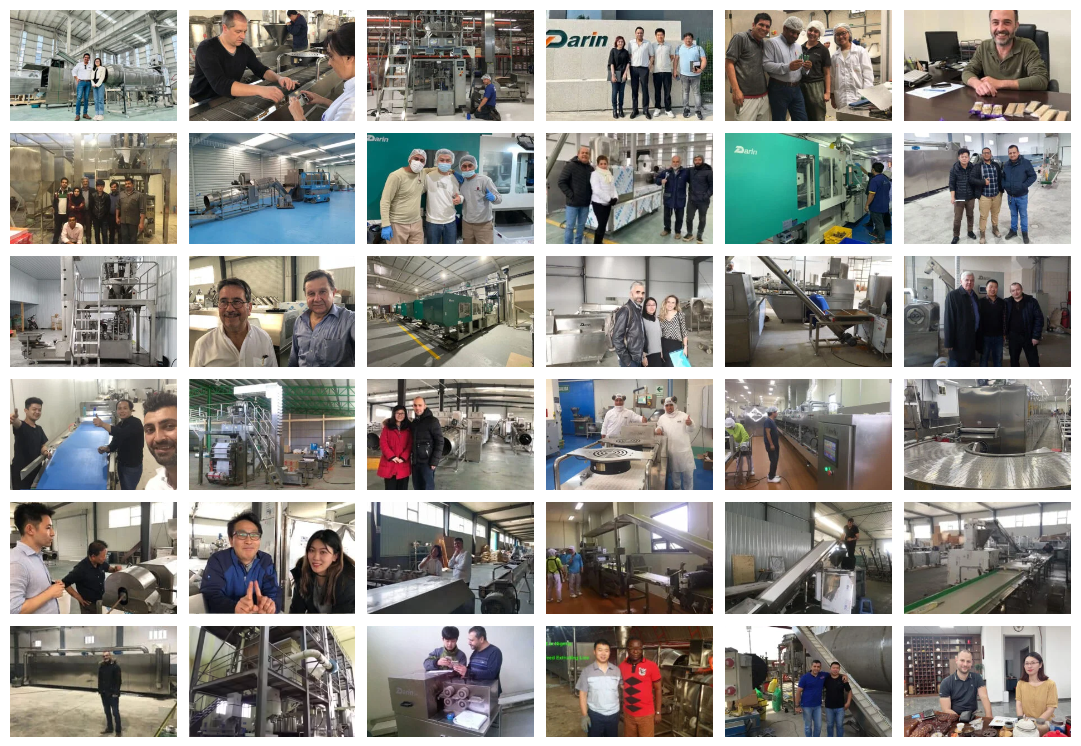
Global Installations
Darin Machinery has supplied pet snack lines to over 70 countries, covering all continents.
Examples include:
- Germany: DR-85 cat treat line integrated with AI temperature control.
- Thailand: DR-70 fish feed and dog chew dual-production line.
- Brazil: 800 kg/h biscuit and baked snack system with hybrid drying.
- South Africa: 400 kg/h low-energy extrusion line with heat recovery.
- Turkey: 1000 kg/h plant producing multi-species snacks for regional export.
Each project includes on-site training, commissioning, and long-term after-sales service — backed by Darin’s global agent network.
Economic and Social Impact
A well-engineered pet snack line contributes not only to profitability but also to regional development.
Economic benefits include:
- Local raw material utilization (corn, rice, meat by-products)
- Job creation in operation, packaging, and logistics
- Export revenue generation through value-added goods
Social benefits include:
- Improved pet nutrition and animal welfare
- Reduction in food waste via by-product valorization
- Compliance with sustainability and ethical sourcing initiatives
Innovation Outlook — The Future of Pet Snack Production
The pet snack industry is transitioning from traditional mass production to personalized, functional, and smart manufacturing models.
Future trends include:
- Nutraceutical Snacks: Functional ingredients such as probiotics, glucosamine, and collagen for specific health benefits.
- Plant-Based Formulas: Alternative proteins (pea, lentil, insect meal) to reduce environmental impact.
- On-Demand Production: Compact modular systems for local micro-factories.
- 3D Printing Integration: Customized treats for veterinary and research use.
- Full Digital Twin Plants: Real-time virtual replicas predicting efficiency and quality outcomes.
These advancements will redefine efficiency, flexibility, and sustainability — and Darin Machinery continues to lead in developing future-ready equipment.
Conclusion
From basic extrusion lines to AI-driven, fully automated smart factories, pet snack production has become a sophisticated intersection of food technology, mechanical engineering, and data science.
By investing in Darin Machinery’s integrated systems, manufacturers gain:
- Multi-species capability (dogs, cats, fish, birds)
- Energy-efficient and hygienic design
- Smart automation and remote control
- Compliance with CE, ISO, FDA, and HACCP
- Long-term reliability and global support
Ultimately, a Darin production line is more than a machine — it’s a strategic asset for any enterprise seeking excellence in the rapidly expanding pet food industry.
Contact Darin Machinery
Looking to bring your pet snack factory to world-class standards?
Our technical experts will help you plan, design, and deliver your turnkey production system.
📞 WhatsApp: +86 156 5000 7983
📧 Email: darin4@darin.cn
🌐 Website: www.petreatsmachine.com
Darin Machinery — Engineering the Future of Pet Snack Production with Intelligence, Innovation, and Integrity.
